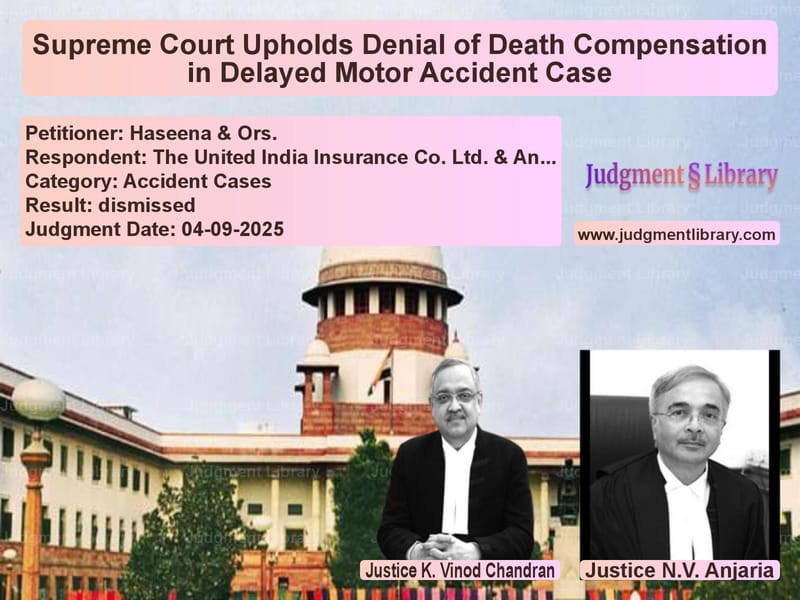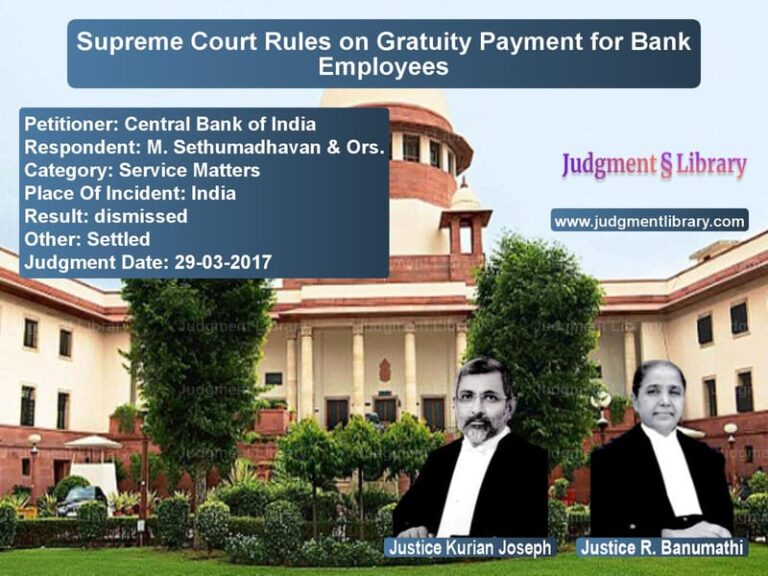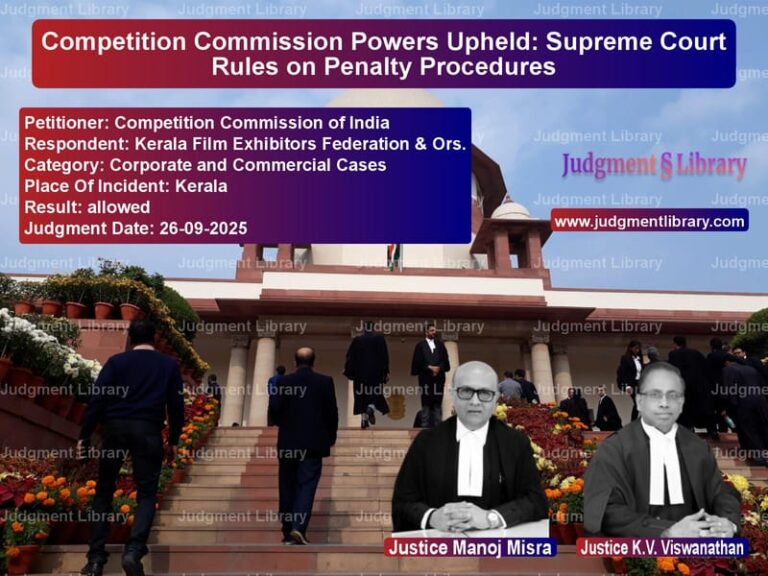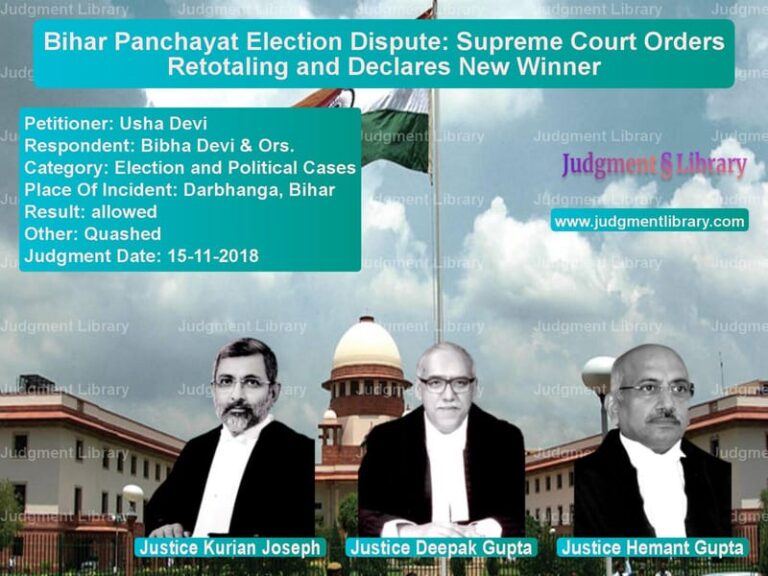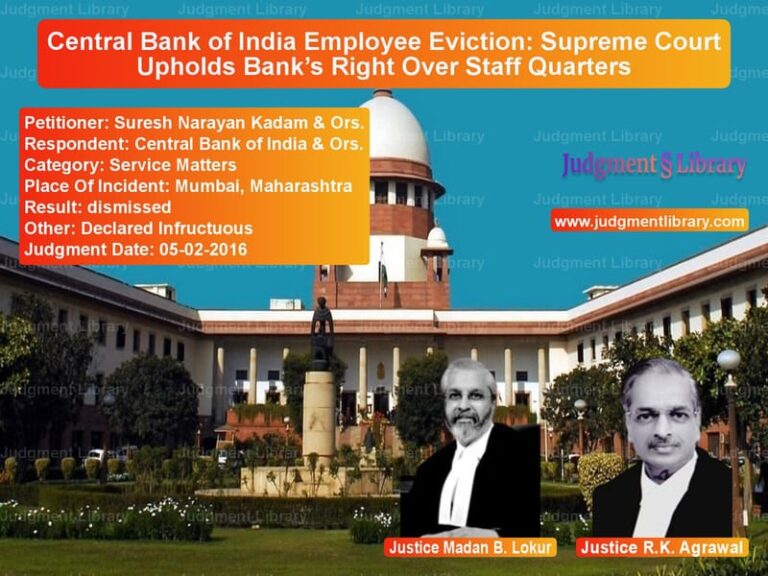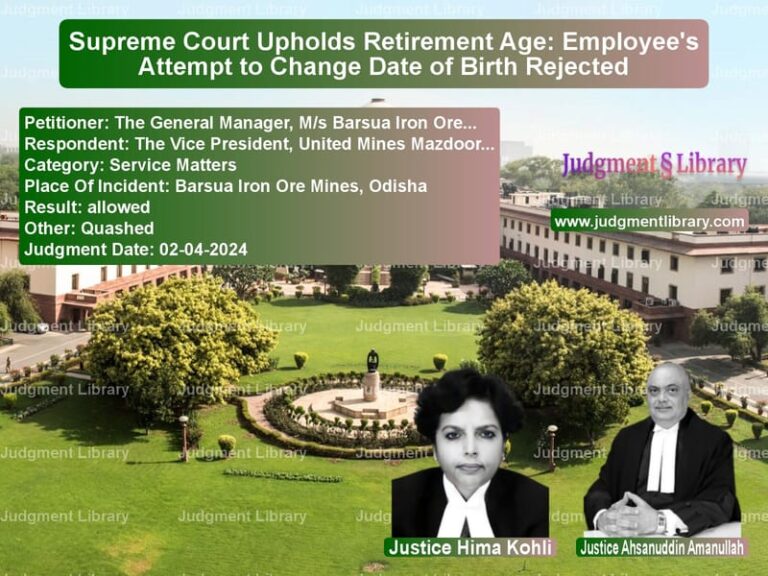Supreme Court Upholds Denial of Death Compensation in Delayed Motor Accident Case
In a judgment that carefully examines the crucial link between accidents and subsequent deaths, the Supreme Court has upheld the denial of death compensation to a family whose breadwinner died five months after a motorcycle accident. The case, which involved complex medical causation questions, highlights the legal requirements for establishing that a death was directly caused by a motor accident rather than intervening medical conditions or treatments.
The tragic sequence of events began on April 29, 2006, when an Excise Guard was involved in a motorcycle collision. The accident occurred around 9 am when the motorcycle driven by the deceased collided with another motorcycle. The injured victim was immediately taken to a nearby hospital where he received treatment for compound fractures of the second, third, and fourth metatarsals of his right foot and a simple fracture of the proximal phalanx of his left little finger. He also sustained a wound at the fracture site. The victim was treated as an inpatient from April 29, 2006, until May 3, 2006, after which he was discharged.
Following his discharge, the victim continued outpatient treatment until August 12, 2006, after which he was referred to a higher medical center for plastic surgery consultation due to a non-healing ulcer on his right foot. On September 18, 2006, the victim was admitted to the higher medical center, where he was advised to undergo surgery. The surgery was performed successfully, but tragically, the victim died abruptly afterward. The cause of death was certified as pulmonary embolism/acute myocardial infarction. The death occurred on September 18, 2006 – almost five months after the original accident.
Read also: https://judgmentlibrary.com/supreme-court-enhances-compensation-for-100-disabled-accident-victim/
The claimants before the Motor Accident Claims Tribunal were the wife, minor child, and mother of the deceased. The Tribunal initially found the death to be a direct consequence of the accident, but this finding was overturned by the High Court. The Supreme Court appeal was filed by the claimants challenging the High Court’s judgment.
The core legal issue before the Supreme Court was whether the death that occurred five months after the accident could be considered a direct result of the injuries sustained in that accident. The appellants, represented by Senior Counsel Mr. Shaji P. Chaly, emphasized the Tribunal’s finding that “the non-healing ulcer on the right foot was consequent to the injuries sustained by the victim in the motor accident.” The Tribunal had also observed that while the injuries sustained were not initially serious, the deceased had undergone skin grafting at the local hospital on two occasions without success, which prompted the referral to a higher center for plastic surgery consultation.
The plastic surgeon who performed the final procedure was examined as PW-1 and had issued Exhibit A-1, which clearly reported the cause of death as pulmonary embolism/acute myocardial infarction. The Tribunal had found that “the proximity of the accident in which the injuries were sustained, with the death, clearly showed the nexus between the accident and the death.” The Tribunal also noted that the cross-examination of PW-1 did not reveal any contra-indication and that there was no history of heart complaints, hypertension, or diabetes.
However, the Supreme Court carefully examined the evidence presented, particularly the testimony of PW-1. While in chief examination, PW-1 stated that “due to the injuries sustained in the accident and continued treatment, pulmonary embolism/acute myocardial infarction can be caused if the patient continues bed rest for long,” his cross-examination revealed crucial details that undermined this connection.
During cross-examination, PW-1 admitted with reference to Exhibit A-9 that “the victim had a history of mild blood pressure and diabetics.” Although no cardiology check-up was conducted before surgery and no heart complaint was detected, cholesterol was found at a high level in the preoperative tests. PW-1 also deposed that hypertrophy with strain pattern detected in the patient was a symptom of cardiac complaint. Importantly, it emerged that “postmortem was not conducted on the deceased since his family objected to it,” and PW-1 clarified that if postmortem had been done, the cause of death could have been ascertained more definitively.
The Supreme Court noted that PW-1 had clarified that “in a patient, with the test results of the nature seen from Exhibit A-9, chances of a heart attack will be more.” The Court observed that “The mere response to the suggestions made, as to the injuries in the accident could have also resulted in myocardial infarction, cannot be taken as a conclusive proof of the death having been caused by reason of the injuries suffered in the accident.”
The Court also considered the testimony of PW-2, the wife of the deceased, who asserted that her husband had no ailments apart from the non-healing ulcer caused by the accident injuries. However, the Supreme Court found that “the statement of PW-2 regarding the health condition of her husband runs contrary to the expert opinion given by the Doctor who was examined by the claimants themselves as PW-1.”
The Supreme Court analyzed the High Court’s reasoning, which had elaborately considered the arguments regarding the cause of acute myocardial infarction. The High Court had rejected the contention that such a condition could occur due to long bed rest, noting that “there is no clear evidence as to such a bed rest having been advised for the patient.” The Court noted that the inpatient treatment was only between April 29, 2006, and May 3, 2006, and afterward, the victim underwent outpatient treatment until August 12, 2006. Although it was contended that he was advised bed rest upon discharge, “there is no specific period of bed rest spoken of by the witness or substantiated by documentary evidence.”
The Supreme Court agreed with the High Court’s assessment that “The death could very well have been the after effect of the surgery, given the medical parameters of the patient. It cannot have any direct nexus to the accident which was not conclusively established; the expert medical opinion being otherwise.”
The Court emphasized that “The injuries suffered in the accident, as deposed by PW-1, the Doctor and found by the Tribunal were not very serious.” The non-healing ulcer could have been caused by various factors, especially since the victim was known to be diabetic, which necessitated the skin grafting procedure. The Court noted that the procedure was carried out successfully, but the patient succumbed in the aftermath of the surgery.
In its concluding observations, the Supreme Court stated that “Merely by reason of the proximity of the accident and the death or the possibility of acute myocardial infarction occurring for reason of a long bed rest, it cannot be assumed, without clear evidence to substantiate the death having been caused as a result of the injuries sustained in the accident that the death occurred by reason of the accident.” The Court found that “There cannot be found even a preponderance of probability, going by the Doctor’s evidence.”
The Supreme Court ultimately declined to interfere with the High Court’s well-considered judgment, which, while rejecting the claim for compensation for death, had considered the claim for injuries sustained. The appeal was dismissed, bringing closure to a legal battle that examined the delicate balance between compensating genuine accident victims and ensuring that compensation is awarded only when there is clear evidence of causation between the accident and the subsequent death.
This judgment serves as an important precedent in motor accident claims involving delayed deaths, emphasizing the need for clear medical evidence establishing causation rather than relying solely on temporal proximity between the accident and death. It underscores the principle that while the Motor Vehicles Act aims to provide relief to accident victims, this relief must be based on established legal principles and credible evidence rather than assumptions or possibilities.
Petitioner Name: Haseena & Ors..Respondent Name: The United India Insurance Co. Ltd. & Anr..Judgment By: Justice K. Vinod Chandran, Justice N.V. Anjaria.Judgment Date: 04-09-2025.Result: dismissed.
Don’t miss out on the full details! Download the complete judgment in PDF format below and gain valuable insights instantly!
Download Judgment: haseena-&-ors.-vs-the-united-india-ins-supreme-court-of-india-judgment-dated-04-09-2025.pdf
Directly Download Judgment: Directly download this Judgment
See all petitions in Road Accident Cases
See all petitions in Compensation Disputes
See all petitions in Motor Vehicle Act
See all petitions in Insurance Settlements
See all petitions in Third-Party Insurance
See all petitions in Judgment by K. Vinod Chandran
See all petitions in Judgment by N.V. Anjaria
See all petitions in dismissed
See all petitions in supreme court of India judgments September 2025
See all petitions in 2025 judgments
See all posts in Accident Cases Category
See all allowed petitions in Accident Cases Category
See all Dismissed petitions in Accident Cases Category
See all partially allowed petitions in Accident Cases Category

